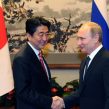
Seventy Years After the End of WWII, the Kuriles Still Roil Russian-Japanese Relations
Publication: Eurasia Daily Monitor Volume: 12 Issue: 195
By:

On October 22, Russian Defense Minister Sergei Shoigu announced that Russia plans to build a military base in the Kurile Islands, annexed by the Soviet Union from Japan at the end of World War II (Zerkalo Nedeli, October 22). Shoigu did not specify what the facility would be. Following Shoigu’s remarks Japan’s Chief Cabinet Secretary Yoshihide Suga said that the government was studying the Russian defense minister’s statements, telling a press conference in Tokyo, “We do not have accurate data, [due to] the form in which the declaration was made, so there will be no further response until after a full examination of this information is made. Our position remains unchanged” (Vzgliad, October 23). Tokyo’s position, since 1945, has been that Russia must return the four southernmost Kurile Islands, a demand that Russia has consistently refused.
The Kurile archipelago straddles the western Pacific Ocean from the northernmost Japanese island of Hokkaido to the southern tip of Russia’s Kamchatka Peninsula. The four southernmost of the chain’s 18 islands—Kunashir, Iturup, Shikotan and the Habomai islets—are called the Southern Kuriles by Russia and the Northern Territories by Japan. The dispute involves the four islands seized by Soviet forces after the Union of Soviet Socialist Republics (USSR) declared war on Japan, on August 8, 1945.
The declaration came three months to the day after the end of the war in Europe, as Joseph Stalin had promised his Western allies at both the Yalta and subsequent Potsdam conferences that the USSR would enter the Pacific theater against Japan after European military operations ended. The declaration nullified the Soviet-Japanese Neutrality Pact of April 13, 1941, which was to run for five years. By September 1, the Soviet seizure of the Kuriles was complete. Since 1956, Japan has persistently demanded the return of the “Northern Territories,” but both the USSR and, since 1991, the Russian Federation, have refuted Japanese claims.
During the Cold War, the Kuriles assumed increasing strategic importance for the USSR because they block the entrance to the Sea of Okhotsk. Beginning in the late 1960s, the Soviet navy introduced the Yankee-class submarine, armed with 16 SS-N-6 submarine-launched ballistic missiles (SLBM). At that time, many Western analysts predicted that the USSR would assume a “bastion defense” concept for this and successive ballistic missile submarines. The “bastion defense” concept involves removing ballistic missile submarines from enemy coastlines into Soviet maritime “bastions”—one of which being the Sea of Okhotsk—making it both difficult for enemy maritime forces to penetrate and easier for the Soviet military to defend (Richard L. Haver, “Soviet Navy Perspectives,” United States Naval Institute Proceedings, May 1988, p. 236).
Yet, Russia’s interest in retaining the Kuriles is not solely nationalistic and military. On Iturup, near the Kudriavyi volcano, is the world’s richest known deposit of rhenium, a rare earth element used in alloys to create components for missile and supersonic aircraft technology (Interfax, August 10). Moreover, nickel-based rhenium super-alloys are used in combustion chambers, turbine blades and jet engine exhaust nozzles. The Iturup rhenium deposit’s discovery was announced in 1994 (Nature 369, May 5, 1994, pp. 51–52).
Because of this element’s low availability relative to demand, rhenium is among the most expensive of metals; in March in the wake of earthquakes in top producer Chile, prices of refined rhenium pellets, used in heat-resistant alloys by the aircraft industry, were quoted at $4,000–$5,200 per kilogram, up from around $3,600–$5,000 per kg the previous week (Reuters, March 31). In August 2015, Interfax reported that Kurile Island production of rhenium could reach up to 40 tons by the year 2025 (Interfax, August 10).
Other mineralogical deposits in the Kuriles include thousands of tons of titanium and iron ore, along with 1,867 tons of recoverable gold and 9,284 tons of silver. The islands are also surrounded by rich fishing grounds (Pravda, January 26, 2012).
Three months before Shoigu made his announcement of new Kurile Island military facilities, Russian Prime Minister Dmitriy Medvedev told reporters that the island chain would be included as a territory of priority development (TOR) for Russia, along with two areas in Khabarovsk krai and one in Primorye. Medvedev added that the total funding of the Kurile program was set at $1.1 billion over the next decade, further noting that he planned to visit the Kurile Islands in the future (Vzgliad, July 23). More recently, on October 15, emphasizing Russia’s military interests in the contested archipelago, Russian Eastern Military District spokesman Aleksandr Gordeev announced that advanced Russian Su-35 fighter jets carried out military exercises near the Kurile Islands (TASS, October 15).
The Kurile dispute remains unresolved since World War II and has kept Russia and Japan from signing a formal peace treaty (see EDM, July 31, October 9). Farther afield, Russia’s expansion of its military bases in both the Arctic and Kurile Islands, combined with its intervention in Syria, is causing concern in the West. An official of the North Atlantic Treaty Organization (NATO), speaking on condition of anonymity, recently told Voice of America, “Russia is increasingly assertive and unpredictable” (Voice of America, October 23). Unlike Japan’s diplomatic dispute with South Korea over the Liancourt Rocks or the Japanese-administered Senkaku Islands, also claimed by China and Taiwan, the Kurile issue is the result of military action, not contested sovereignty claims based on historical maps and documents. As Vladimir Putin’s administration has been increasingly flexing Russia’s military prowess against opponents ranging from NATO to the Islamic State, it would seem that diplomacy remains Japan’s best option, despite a lack of success over seven decades.




